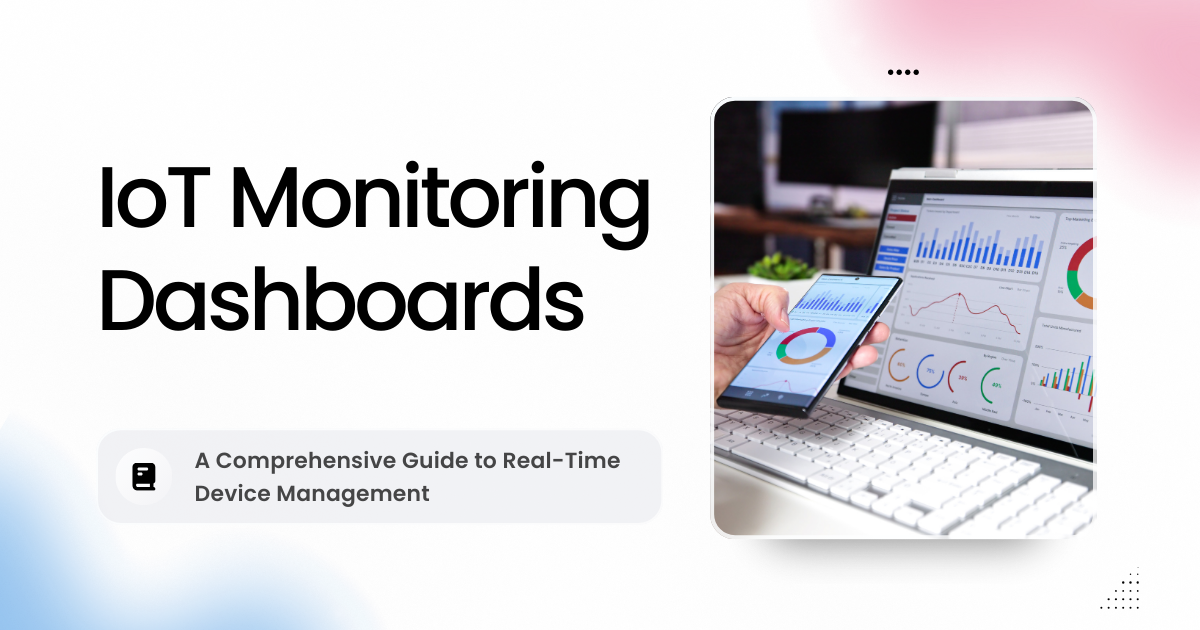IoT Monitoring Dashboards: A Comprehensive Guide to Real-Time Device Management

The Internet of Things (IoT) is rapidly expanding, connecting billions of devices worldwide. According to Statista, the number of connected IoT devices is expected to reach 29 billion by 2030. With this growth, the ability to manage, monitor, and interpret real-time data has become essential. Businesses now rely heavily on IoT Dashboard Solutions to oversee devices, detect issues early, and make faster, data-driven decisions.
This article explores how IoT monitoring dashboards work, why they are critical in modern industries, and what makes them an essential part of digital operations today.
Why IoT Monitoring Dashboards Matter
IoT devices collect enormous amounts of data every second—ranging from temperature sensors in manufacturing units to GPS trackers in logistics. However, raw data by itself holds little value. The challenge lies in presenting this information in a way that is understandable and actionable.
This is where dashboards come in. IoT Dashboard Development Services transform complex device data into interactive visualizations, enabling operators, managers, and technicians to see performance insights in real time.
Consider a logistics company:
- GPS devices track vehicles.
- Sensors measure fuel consumption.
- RFID tags monitor cargo conditions.
If each dataset stayed in silos, managing operations would be nearly impossible. But with an IoT dashboard, all this information can be displayed in one interface, allowing decision-makers to respond instantly when something goes wrong.
Key Features of Effective IoT Dashboards
Not all dashboards are built the same. Some are designed for simple monitoring, while others support predictive analytics and advanced reporting. The most effective IoT Dashboard Solutions usually share the following features:
1. Real-Time Data Updates
Devices constantly send new information. A good dashboard reflects these changes instantly, helping teams react without delays.
2. Customizable Views
Different stakeholders need different insights. For instance, an engineer may need sensor logs, while an executive prefers KPI summaries. Custom views make dashboards useful across departments.
3. Alerts and Notifications
Dashboards can send alerts when thresholds are crossed—for example, if a machine overheats or a shipment is delayed.
4. Historical Data and Trends
Beyond real-time monitoring, dashboards must allow users to view historical performance and identify long-term trends.
5. Integration with Other Systems
Dashboards that integrate with ERP, CRM, or predictive analytics tools create a more holistic ecosystem for managing operations.
Real-World Applications of IoT Dashboards
IoT dashboards are not industry-specific. They are being applied in multiple domains, each with unique use cases.
Manufacturing
Factories use IoT dashboards to monitor production lines, track equipment health, and reduce downtime through predictive maintenance.
Healthcare
Hospitals rely on IoT dashboards for patient monitoring devices, ensuring real-time visibility into vital signs and reducing emergency response time.
Smart Cities
Cities employ IoT dashboards for traffic management, air quality tracking, and smart street lighting. Real-time insights improve urban living conditions and sustainability.
Agriculture
Farmers use dashboards to track soil moisture, weather conditions, and equipment usage, enabling more precise crop management.
Logistics and Supply Chain
Fleet managers monitor routes, fuel consumption, and cargo conditions through dashboards, ensuring efficiency and reliability.
Each of these examples highlights how dashboards turn device data into practical, real-time decision-making tools.
Also Read: Using IoT and AI in Smart Farming to Gain a Competitive Edge
Challenges in Building IoT Dashboards
While dashboards are critical, creating them is not without challenges. Companies investing in IoT Dashboard Development Services must address the following hurdles:
- Data Overload: Billions of devices generate massive amounts of data. Dashboards must handle this without slowing down.
- Scalability: As businesses grow, dashboards must scale to manage thousands—or even millions—of devices.
- Security: Sensitive data, such as healthcare or financial information, must be protected from cyber threats.
- User Experience: A cluttered dashboard can confuse users. Simplicity and clarity are key.
- Integration Complexity: Combining IoT data with legacy systems often requires advanced development expertise.
Overcoming these challenges requires careful planning, a strong technical foundation, and a clear understanding of business needs.
Best Practices for Effective IoT Dashboard Solutions
When designing or implementing dashboards, businesses should follow a few best practices:
- Define the Audience: Understand who will use the dashboard—engineers, executives, or field operators.
- Prioritize Metrics: Not all data is relevant. Identify key metrics that truly impact performance.
- Ensure Scalability: Choose solutions that can grow as the device ecosystem expands.
- Focus on Security: Protect dashboards with encryption, authentication, and secure data channels.
- Enable Mobile Access: With remote teams, dashboards should be accessible on mobile devices as well.
By following these principles, companies can maximize the value of their IoT investments.
The Future of IoT Dashboards
The future points toward dashboards becoming even smarter. Artificial intelligence and machine learning will play a larger role, enabling predictive insights instead of just descriptive ones. Instead of only reporting a problem, future dashboards could recommend corrective actions automatically.
For example, in a smart energy grid, a dashboard may not only show that consumption is peaking but also suggest redistributing loads to prevent outages. Similarly, in healthcare, dashboards might predict patient risks before they escalate.
These advancements highlight the importance of choosing flexible IoT Dashboard Development Services that can evolve with technology trends.
Conclusion
IoT monitoring dashboards are no longer optional—they are central to real-time device management in almost every sector. By presenting complex data in an accessible and actionable format, dashboards enable organizations to improve efficiency, reduce risks, and plan better for the future.
As connected devices multiply, the demand for advanced IoT Dashboard Solutions will continue to grow. Businesses that invest wisely in dashboards today will find themselves better prepared to handle tomorrow’s challenges.
Frequently Asked Questions (FAQs)
1. What is an IoT monitoring dashboard?
It is a platform that visualizes real-time data from connected devices, allowing users to monitor, analyze, and act on insights.
2. Why are IoT dashboards important?
They simplify complex IoT data, making it easier for businesses to manage devices, detect issues, and optimize operations.
3. What industries benefit most from IoT dashboards?
Industries like manufacturing, healthcare, logistics, agriculture, and smart cities gain the most from real-time dashboards.
4. Can IoT dashboards integrate with existing systems?
Yes. Many modern solutions integrate with ERP, CRM, and other enterprise platforms for seamless data flow.
5. How do IoT Dashboard Development Services help businesses?
They provide customized dashboards tailored to business needs, ensuring scalability, security, and actionable insights.



